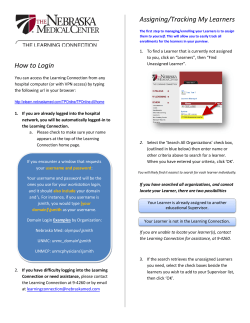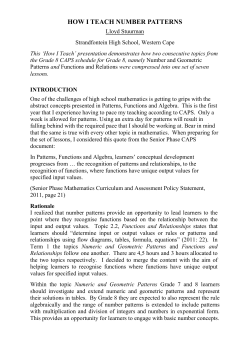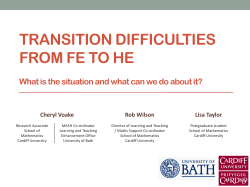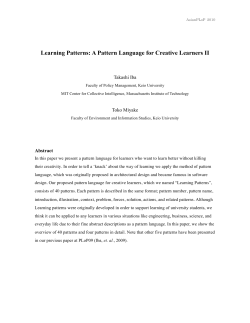
TDA 3.2 Schools as organisations Introduction
TDA 3.2 Schools as organisations Introduction This unit aims to prepare the learner for working in a school. It covers key aspects of schools as organisations. This includes the structure of the education system, the roles and responsibilities of key members of the school team and the purpose of school ethos, mission statement and aims and values. Learners will also understand the reasons for the key legislation, policies and procedures which are followed in schools and how schools operate within a wider context. Learning outcomes This unit has six learning outcomes: 1 Know the structure of education from early years to post-compulsory education. 2 Understand how schools are organised in terms of roles and responsibilities. 3 Understand school ethos, mission, aims and values. 4 Know about the legislation affecting schools. 5 Understand the purpose of school policies and procedures. 6 Understand the wider context in which schools operate. This unit has links to the following National Occupational Standards: Ɣ SWiS 3.2 Support the ethos, policies and working practices of the school. Additional guidance for delivery For session 1, learners could carry out research into the various types of education provision available in their area. In session 2, learners could find out in placement how their school is structured and research the roles of the governors and anyone else who is involved in the running or funding of the school (e.g. PTA) In session 3, learners could watch a video of learning taking place in the classroom and compare the ethos and aims of the school to their own placement school. For session 4, learners could carry out further research into the legislation that affects them, other staff and pupils. For session 5, learners could collect the school’s inclusion policy and discuss in their groups the impact of having an inclusion policy within school. Further resources Ɣ Ɣ Ɣ Ɣ Ɣ Ɣ Burnham, L. and Baker, B. (2010) Level 3 Diploma Supporting Teaching & Learning in Schools, Heinemann Briggs, S. (2004) Inclusion, and how to do it: Meeting SEN in Secondary Classrooms, David Fulton Publishers www.direct.gov.uk www.dcsf.gov.uk/everychildmatters www.tda.gov.uk www.teachernet.gov.uk/wholeschool Continued overleaf 1 © The TA College 2010 under licence to Pearson Education Limited. Printing and photocopying permitted. TDA 3.2 Schools as organisations Level 3 Diploma in Supporting Teaching & Learning in Schools TDA 3.2 Introduction continued Answers to activities A1: Structure of education Task 1 Every three- and four-year-old child is entitled to free early years education in an Ofsted inspected setting which is found to be satisfactory. The funding is available for 12.5 hours a week for 38 weeks of the year. Free places are available in a number of settings including: school nurseries, childminders and private day nurseries. A4: Legislation affecting schools Children Act 2004 Schools are not to discriminate against disabled children this has led to more disabled children in mainstream schools. Data Protection Act 1998 Close relationship between agencies and sharing of information between agencies Disability Discrimination Act 1995 and Special Educational Needs Code of Practice Designed to protect everyone within the school and gives procedures to follow in the event of an accident. Health and Safety at Work Act 1974 Schools are required to keep information secure and it can only be used for the purpose it was gathered for. 2 © The TA College 2010 under licence to Pearson Education Limited. Printing and photocopying permitted. Delivery notes Task 1 confirms the learner’s knowledge of the funded nursery places available to three- and fouryear-olds. Task 2 is a case study which asks the learners to research the post 16 education available to learners. Task 1 is a table for the learners to fill out to explain the job roles of people within a school. Task 2 is an activity where they need to ask which educational professionals attend their school and write an overview of their involvement. Task 1 confirms that students know the meaning of the school’s ethos, mission, aims and values. Task 2 asks the learners to evaluate the various methods by which these can be communicated. The first part of this activity is a linking exercise – learners must match the legislation to the description. The activity then goes on to show how this legislation affects the day-to-day running of the school. © The TA College 2010 under licence to Pearson Education Limited. Printing and photocopying permitted. Task 1 is an activity based on the school policies and how they affect the school. Task 2 asks the learners to look at how the policies are communicated and developed. The wider context A6 This activity asks learners to research the wider context within which schools operate, considering the effects of the government, community and other organisations. 6 Understand the wider context in which schools operate Policies and procedures A5 5 Understand the purpose of school policies and procedures Legislation affecting schools A4 4 Know about the legislation affecting schools School ethos and mission A3 3 Understand school ethos, mission, aims and values Roles and responsibilities A2 2 Understand how schools are organised in terms of roles and responsibilities Structure of education A1 1 Know the structure of education from early years to post-compulsory education Resources Overview of resources: TDA 3.2 Overview of resources continued English: Reading and writing English: Reading English: Speaking, listening and communication ICT: Developing, presenting and communicating information Link to Functional Skills Continued overleaf Link to textbook TDA 3.2 Schools as organisations Level 3 Diploma in Supporting Teaching & Learning in Schools 1 Interactive quiz covering learning from TDA 3.2 for revision purposes, designed to be completed individually by learners (e.g. via a VLE) or as a group in a group session. Knowledge Check Schools as organisations This short PowerPoint presentation introduces learners to the idea of schools as organisations, including their mission and ethos, policies and procedures and the legislations they must follow. At the end, learners are asked to consider how different policy areas affect their daily role in school. Delivery notes PowerPoint P1 Electronic resources Resources Overview of resources continued Link to Functional Skills © The TA College 2010 under licence to Pearson Education Limited. Printing and photocopying permitted. Continued overleaf Link to textbook TDA 3.2 Schools as organisations Level 3 Diploma in Supporting Teaching & Learning in Schools 2 © The TA College 2010 under licence to Pearson Education Limited. Printing and photocopying permitted. 3 2 1 Session number Learners can complete Activity 3 Task 2 in class if you have previously asked them to bring copies of the mission statement with them. Alternatively, learners could complete this task while on placement. (3.1/3.2) Learners could watch a video of learning taking place in the classroom and compare the ethos and aims of the school to their own placement school. Activity A3 Task 1 will help learners to understand the meaning of the terms ethos, mission, aims and values. You may ask learners to discuss why it is important that a school has these in place and what happens if they are not followed. You may like to have group discussions about the various visitors who come into school to work alongside the SENCO and other staff, before asking learners to complete Activity 2 Task 2 in school. Learners could find out in placement how their school is structured, the function of the governors and anyone else who is involved in the running or funding of the school (e.g. the PTA). You may wish to use the whiteboard to discuss the hierarchy of all the differing positions within a school, who manages who and the important parts that they play in the smooth running of the school. The debate of whether the chair of governors or the head teacher is at the top can be interesting, along with the discussion of whether the school can function without the caretaker. Activity A2 Task 1 reinforces the responsibilities of the key members of the school team. Consolidation of the knowledge of the characteristics of different schools is available within the interactive quiz. Learners will be able to understand the ethos, mission, aims and values of a school and explain how they are reflected in work practices. They will be able to evaluate methods of communicating a school’s ethos, mission, aims and values. (2.1/2.2) Learners will understand how schools are organised in terms of roles and responsibilities. They will be able to explain the strategic purpose of school governors, the senior management team, other statutory roles such as the SENCO, teachers and support staff roles. Learners will also be able to explain the roles of other external professionals who may work with a school. (1.1/1.2/1.3) To begin this session you could establish a discussion on the various types of provision available for early years, school age pupils and post-16. Learners could carry out research into the various types of education provision available in their area. Learners will know the structure of education from early years to post-compulsory education. They will be able to summarise entitlement and provision for early years education, and the characteristics of different types of schools in relation to educational stages and school governance as well as being able to explain the post-16 options for young people and adults. Activity A1 will help learners to consider some of the options for early years along with evaluation of the post-16 options available within the case study. Activities and resources Learning outcomes/Assessment criteria Scheme of work: TDA 3.2 Scheme of work continued Continued overleaf English: Speaking, listening and communication ICT: Developing, presenting and communicating information Functional Skills TDA 3.2 Schools as organisations Level 3 Diploma in Supporting Teaching & Learning in Schools 1 6 5 4 Session number Learners could carry out further research into the legislation that affects them, other staff and pupils. (4.1/4.2/4.3) (6.1/6.2/6.3) Learners will be able to understand the wider context in which schools operate. They will be able to summarise the roles and responsibilities of national and local government for education policy and practice and explain the roles of schools in national policies relating to children, young people and families. They will be able to explain the roles of other organisations working with children and young people and how these may impact on the work of schools. (5.1/5.2/5.3) Learners will understand, and be able to explain, the purpose of school policies and procedures. They will be able to summarise the policies and procedures relating to staff, pupil welfare, teaching and learning, equality, diversity and inclusion and parental engagement. They will also be able to evaluate how school policies and procedures may be developed and communicated. You may like to provide overviews of key legislation such as Children’s Act 2004, Data Protection Act 1998 or Disability Discrimination Act 1995 along with the SEN Code of Practice and the Health and Safety at Work Act 1974 to highlight key points. Alternatively, learners could spend time researching the key points to come up with a set of 5 to 10 bullet points to summarise, in groups or independently. Learners will know about the legislation affecting schools. They will be able to summarise the laws and codes of practice affecting work in schools and explain how legislation affects how schools work. They will be able to explain the roles of relevant regulatory bodies which exist to monitor and enforce the legislative framework including general and school-specific bodies. As a group, or on an individual basis, ask the learners to complete the Interactive Knowledge Check to finish the unit. The piece of writing that learners need to complete for Activity A6 will allow them to demonstrate what they have learned. The learners could carry out some independent or group research to find out information on the responsibilities of national government for education policy, the role of schools in national policies relating to children, young people and families and the roles of other organisations. A whole group discussion on how school policies and procedures can be developed and communicated could follow. After introducing why schools have policies and procedures in place a discussion regarding the use of policies and procedures may be useful. Learners could then complete Activity A5 using information collected in school or examples of policies. Activity A4 will help learners to consolidate their knowledge of the key legislation relevant to them within their roles. Activities and resources Learning outcomes/Assessment criteria Scheme of work continued Continued overleaf English: Reading and Writing English: Reading Functional Skills TDA 3.2 Schools as organisations Level 3 Diploma in Supporting Teaching & Learning in Schools © The TA College 2010 under licence to Pearson Education Limited. Printing and photocopying permitted. 2 TDA 3.2 Schools as organisations AC: 1.1, 1.3 FS: ICT: Developing, presenting and communicating information A1 Structure of education Task 1 Local education authorities are funded by the government to ensure that every threeand four-year-old child has access to free part-time education. Fill in the missing words and numbers in the following paragraph from the box below: early years Every three- and four-year-old child is entitled to inspected setting which is found to be education in an The funding is available for hours a week for weeks of the year. Free places are available in a number of settings including:# school nurseries, childminders and private day nurseries. satisfactory free 12.5 Ofsted 38 Task 2 Case study: Considering post-16 options Patrick has left school at 16 with five GCSEs and is unsure about what to do next. He is interested in a career in physical education. What education and training options are available to him? 1 Carry out independent research to see what options Patrick has. 2 Working in small groups, discuss and research the various options available to Patrick and consider the positive and negative aspects of each choice. Fill in the table below to show your findings: Patrick’s options Positive aspects Negative aspects Functional Skills You could present your findings for this task in a flow chart. This will help you to develop your editing skills. 1 © The TA College 2010 under licence to Pearson Education Limited. Printing and photocopying permitted. TDA 3.2 Schools as organisations AC: 2.1, 2.2 A2 Roles and responsibilities FS: English: Speaking, listening and communication Task 1 Within a school there are different people with various roles, all of which are necessary to ensure the smooth running of the school. Complete the table below to show the responsibilities of the school governors, senior management team, teachers, support staff and the SENCO (Special Educational Needs Co-ordinator). Job role Responsibilities School governors Volunteers who ensure the school provides a good quality education. Set the aims and policies of the school. Set the school’s budget. Senior management team Teachers Support staff SENCO Task 2 As a Teaching Assistant you may be expected to work alongside many different education professionals. Talk to your class teacher or SENCO about the various educational professionals who visit the school and what they do. These may include speech therapists, child psychologists and other support workers who visit the school. Now write an overview of what the educational professionals do in your school. Complete your answers on a separate sheet of paper. Functional Skills You may be able to carry out short interviews with each of these professionals in order to explore their job roles. Plan your questions first so that you are prepared and can make relevant contributions to the discussion. 1 © The TA College 2010 under licence to Pearson Education Limited. Printing and photocopying permitted. TDA 3.2 Schools as organisations AC: 3.1, 3.2 A3 School ethos and mission Task 1 Each school will have a mission statement, ethos, aims and values. Use your textbook to find out the meaning of the following terms. Ɣ Ɣ Ɣ Ɣ Ethos Mission Aims Values. Task 2 Ask your school if you can have a copy of its mission statement. Alternatively, this information is often available on the school website. In groups talk about how the ethos, mission statement, aims and values of a school may be reflected in your working practice while at the school. Fill out the table to show the different methods of communicating a school’s ethos, mission statement, aims and values and evaluate the different methods. Ensure that you look at the advantages and disadvantages of each method. Method of communicating Advantages Disadvantages 1 © The TA College 2010 under licence to Pearson Education Limited. Printing and photocopying permitted. TDA 3.2 Schools as organisations AC: 4.1, 4.2, 4.3 A4 Legislation affecting schools Task 1 There are some laws set in place by government which schools have a duty to follow. A few of these– and the main points involved – have been stated below. Link the legislation on the left to the correct description on the right: Children’s Act 2004 Schools are not to discriminate against disabled children this has led to more disabled children in mainstream schools. Data Protection Act 1998 Close relationship between agencies and sharing of information between agencies Disability Discrimination Act 1995 and Special Educational Needs Code of Practice Designed to protect everyone within the school and give procedures to follow in the event of an accident. Health and Safety at Work Act 1974 Schools are required to keep information secure and it can only be used for the purpose it was gathered for. Task 2 Complete the table below to show how the various pieces of legislation affect the day-to-day running of a school. An example has been started for you. Legislation How it affects the school... Data Protection Act 1998 1 © The TA College 2010 under licence to Pearson Education Limited. Printing and photocopying permitted. TDA 3.2 Schools as organisations AC: 5.1, 5.2, 5.3 A5 Policies and procedures FS: English: Reading Task 1 All schools must have certain policies and procedures which they follow. These will cover things like behaviour management, equal opportunities and inclusion. Explain below why schools have policies and procedures. In school, ask for a copy of the policies and procedures. From this, write a summary of how these policies and procedures relate to: Ɣ Ɣ Ɣ Ɣ Ɣ staff pupil welfare teaching and learning equality, diversity and inclusion parental engagement. Task 2 On a separate piece of paper write a short piece on the communication and development of policies in your school. Try to consider the following: Ɣ Ɣ Ɣ Ɣ How are school policies communicated in your school? Do you feel there is a better way for them to be communicated? How are school policies developed? How often are these developed or reviewed? Functional Skills Summarising information from different sources will help you to develop your reading skills. 1 © The TA College 2010 under licence to Pearson Education Limited. Printing and photocopying permitted. TDA 3.2 Schools as organisations AC: 6.1, 6.2, 6.3 A6 The wider context FS: English: Reading and writing Task 1 Most schools in the UK are state/mainstream schools which are funded by the local authority and follow the national curriculum. Carry out some independent research into the wider context in which schools operate. Ɣ Ɣ Ɣ Look at the roles and responsibilities of national and local government for education policy and practice. Look at the role of the school in national policies relating to children, young people and families. Look at the roles of other organisations which work with children and young people and how these may impact on the work of schools. Task 2 On a separate piece of paper, explain the information you have researched. Functional Skills You will be developing your reading skills by using at least three different texts to research this task. Presenting your findings in the form of a written report will allow you to develop your writing skills. 1 © The TA College 2010 under licence to Pearson Education Limited. Printing and photocopying permitted.
© Copyright 2025









